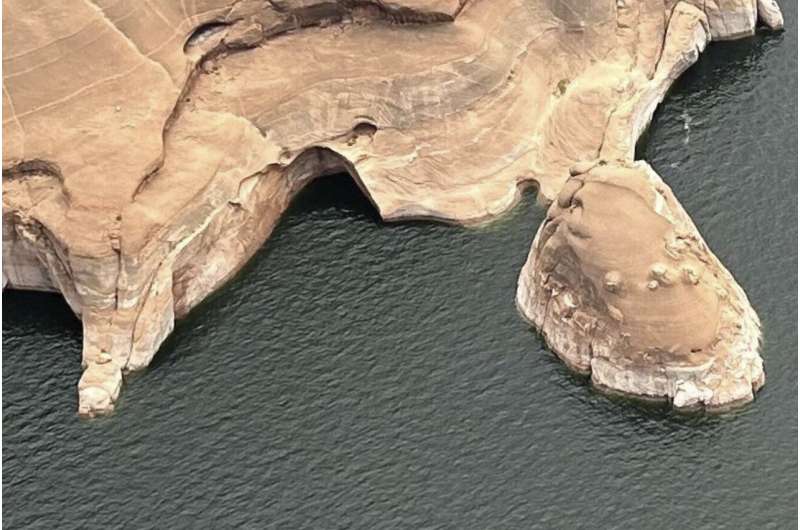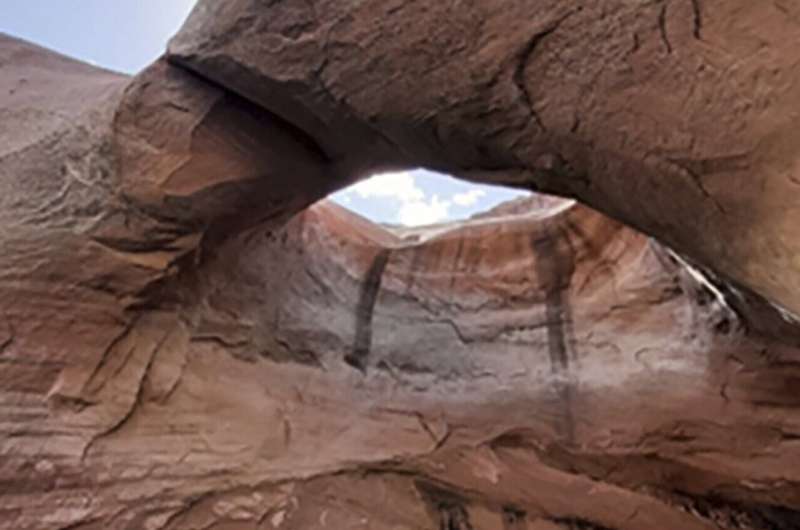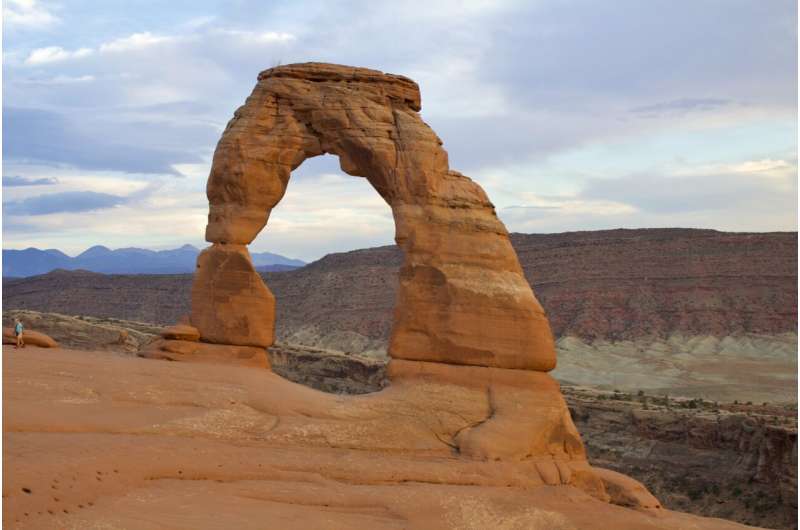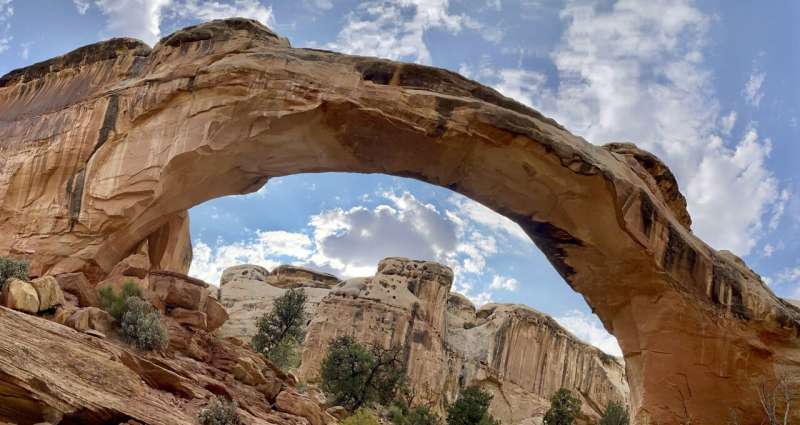2024-08-16 04:17:54
phys.org

A common line of questions has emerged from visitors to Utah’s Arches National Park in the week since an iconic rock arch at Lake Powell known as the “Toilet Bowl” collapsed.
Are these arches also at risk of falling soon? What are you doing to prevent their collapse?
The answers: They might be, and nothing, said Karen Garthwait, spokesperson for Arches and Canyonlands national parks.
“Our mission is not to freeze time and preserve these structures exactly as they are,” she said. “Our mission is to preserve the natural processes that create these structures, which of course, is the same process that will eventually undo them as well.”
When the geological formation formally named “Double Arch” crumbled last Thursday at Glen Canyon National Recreation Area, it served as a sad reminder to many that arches are not guaranteed to stand forever. All arches have a lifespan, which scientists are trying to avoid shortening—or extending.
Experts say human activity has sped up erosion within the last hundred years, making arches susceptible to crumbing at any given time. But when exactly they might fall can be tough to predict.
The outward appearance of an arch gives little indication of its stability. Those that appear most sturdy can have internal cracks, while others that appear to defy gravity may better withstand the elements.

Southern Utah’s sandstone bedrock is strong enough to support the weight of large arches—one of the sturdiest shapes found in nature—but soft enough to be sculpted over time by wind, water and gravity, according to the Utah Geological Survey. The region’s semi-arid climate also plays an important role in forming and sustaining the sandstone wonders.
While the National Park Service is not physically fortifying arches—it abandoned a plan to coat one in plastic in the 1940s—it has enacted strict policies to limit human impact on the natural structures.
As recently as two decades ago, parkgoers could be seen walking on top of some arches and hanging on them for photos. A climber even scaled Delicate Arch, the most widely recognized of Utah’s more than 6,000 arches, leaving rope grooves in the sandstone that Garthwait said can still be seen today. The ascent led park officials to reword regulations in 2006 to make clear that climbing arches is prohibited.
At Lake Powell, a large reservoir on the border of Utah and Arizona, families frequently climbed the now-fallen arch and plunged into a swimming hole below. Park rangers and geologists suspect a combination of regular foot traffic and changing water levels contributed to the arch’s demise. The reservoir’s water levels have been declining due to drought and climate change since 2001, according to the National Park Service.
“Some people have the sense that rock is strong and humans don’t affect it,” said Jeff Moore, a geology and geophysics professor at the University of Utah. “When these kinds of collapse happen, it’s a reminder that arches are really fragile. Subtle changes can make a difference.”

Moore has led research projects that measure the seismic activity beneath Utah’s arches and use civil engineering principles to assess their structural health. The rock formations are constantly vibrating, he said, and human-made energy sources such as trains, trucks and helicopters are increasing those vibrations, placing stress on the arches and accelerating crack growth.
The Federal Aviation Administration imposed air restrictions last year for helicopters flying near Utah’s Rainbow Bridge National Monument—one of the world’s largest known natural bridges—to avoid vibration-induced damage in light of Moore’s research.
Humans have dramatically changed the vibration landscape within the last century, he said, and more arches could soon fall as a result.
“This is a really rapid change in the lifespan of an arch,” Moore said. “Geology moves slowly. Humans have arrived quickly and, in some places, are making dramatic changes in the environment.”
A U.S. Bureau of Reclamation facility in western Colorado that removes salt water from the Colorado River system and injects it deep into the ground has also been linked to earthquakes near Utah national parks. The site was temporarily closed after a 4.5 magnitude earthquake was recorded there in 2019 but has since resumed operations at a reduced rate.

For Richard Beckman, president of the Natural Arch and Bridge Society, knowing that some of the world’s most iconic arches might fall in his lifetime adds a sense of urgency to visit them before they’re gone.
“It’s like losing an old friend,” Beckman said. “I’m sad to see them go, but I’m hurt more by the arches that collapsed that I never saw in person. We don’t know how long they’re going to last, so you have to go appreciate them.”
© 2024 The Associated Press. All rights reserved. This material may not be published, broadcast, rewritten or redistributed without permission.
Citation:
The collapse of an iconic arch in Utah has some wondering if other famous arches are also at risk (2024, August 16)
retrieved 16 August 2024
from https://phys.org/news/2024-08-collapse-iconic-arch-utah-famous.html
This document is subject to copyright. Apart from any fair dealing for the purpose of private study or research, no
part may be reproduced without the written permission. The content is provided for information purposes only.
Support Techcratic
If you find value in our blend of original insights (Techcratic articles and Techs Got To Eat), up-to-date daily curated articles, and the extensive technical work required to keep everything running smoothly, consider supporting Techcratic with Bitcoin. Your support helps me, as a solo operator, continue delivering high-quality content while managing all the technical aspects, from server maintenance to future updates and improvements. I am committed to continually enhancing the site and staying at the forefront of trends to provide the best possible experience. Your generosity and commitment are deeply appreciated. Thank you!
Bitcoin Address:
bc1qlszw7elx2qahjwvaryh0tkgg8y68enw30gpvge
Please verify this address before sending any funds to ensure your donation is directed correctly.
Bitcoin QR Code
Your contribution is vital in supporting my efforts to deliver valuable content and manage the technical aspects of the site. To donate, simply scan the QR code below. Your generosity allows me to keep providing insightful articles and maintaining the server infrastructure that supports them.

Privacy and Security Disclaimer
- No Personal Information Collected: We do not collect any personal information or transaction details when you make a donation via Bitcoin. The Bitcoin address provided is used solely for receiving donations.
- Data Privacy: We do not store or process any personal data related to your Bitcoin transactions. All transactions are processed directly through the Bitcoin network, ensuring your privacy.
- Security Measures: We utilize industry-standard security practices to protect our Bitcoin address and ensure that your donations are received securely. However, we encourage you to exercise caution and verify the address before sending funds.
- Contact Us: If you have any concerns or questions about our donation process, please contact us via the Techcratic Contact form. We are here to assist you.
Disclaimer: As an Amazon Associate, Techcratic may earn from qualifying purchases.



























































![PANIC!!! UFO Sightings OVER Oregon! [UFO SPLIT's APART] Family Reaction! 2015](https://techcratic.com/wp-content/uploads/2024/11/1732693864_maxresdefault-360x180.jpg)









